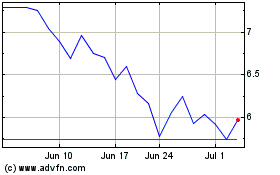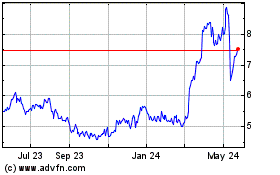By Alexandra Bruell
When companies get in trouble over their advertisements, it
usually happens quickly. In the case of Sherwin-Williams Co., it
took more than a century.
The paint maker is fighting a California court ruling that
ordered it and two other companies to collectively pay hundreds of
millions of dollars in damages for promoting lead paint over
several decades, when they allegedly knew or should have known it
was hazardous. The litigation has highlighted Sherwin-Williams ads
dating back to 1904.
Sherwin-Williams and its co-defendants in July petitioned the
U.S. Supreme Court to take up the case, arguing that they were
unaware of the health risks of lead before it became accepted
science and are being improperly punished for truthful advertising
about a product that was legal at the time. The federal government
banned the use of lead paint in homes in 1978.
Companies already put their advertisements through a range of
stress tests to ensure legal and regulatory compliance, adding
careful wording and disclosures. But some advertising executives
say the Sherwin-Williams ruling, if upheld, would raise the stakes,
forcing marketers to consider whether advertising a product may
open them to liability many years down the road.
That, in turn, could lead creative teams on Madison Avenue --
which wasn't implicated in the lead-paint litigation -- to exercise
even more caution when dreaming up ads and bulk up on
disclaimers.
"You can't demand companies to have clairvoyance," said Dan
Jaffe, executive vice president of government relations for the
Association of National Advertisers, a trade group of marketers
that filed a brief in support of Sherwin-Williams. "It's the
precedent we're concerned about. We believe that what they're doing
in regard to Sherwin-Williams certainly would apply to many other
categories."
The ruling could potentially affect advertising of a range of
products that are subject to frequent studies about their health
effects, including everyday food items and consumer products, some
ad executives said. "We're constantly learning things about
products we didn't think were of any concern," said Mr. Jaffe.
Harris Diamond, chief executive of McCann Worldgroup, a network
of creative agencies owned by ad giant Interpublic Group of Cos.,
said while companies are always mindful of potential liability from
ads, "I do think this is a reach that's further and more than we've
seen in the past."
In some ways, the fight echoes the legal battle over tobacco
marketing in the 1990s. In that case, government officials said
there was clear evidence tobacco companies knew of the health risks
of cigarettes and deceived the public. A massive settlement between
state attorneys general and the tobacco firms resulted in
significant restrictions on advertising and huge payments to states
by the firms.
The health effects of lead are now well known. Exposure to it
can affect physical and mental development in a variety of ways,
especially in children, from behavioral and learning problems to
slowed growth, according to the U.S. Environmental Protection
Agency.
The state of California argued in its suit that several paint
companies were aware of lead paint's toxicity for years while they
marketed it. In the case of Cleveland-based Sherwin-Williams, the
plaintiff referred to an internal communication in 1900 that
described white lead -- which was used in paint -- as a "deadly
cumulative poison." The defendants said they didn't have knowledge
of risks now known to be associated with lead-based paint.
A California trial court ruled for the state in 2014, ordering
Sherwin-Williams and two other companies involved in manufacturing
and marketing lead paint in California, ConAgra Grocery Products
Co. and NL Industries Inc., to pay $1.15 billion into a state fund
that would go toward removing health hazards posed by lead paint in
California homes.
An appeals court last year said the companies should only be
liable for lead-paint usage before 1951 because there was
"insufficient evidence" the defendants had promoted lead paint for
interior use after 1950. This could reduce the damages to between
$409 million and $730 million, according to a Sherwin-Williams
filing.
But the appeals court upheld the substance of the ruling. It
pointed to a Sherwin-Williams ad from 1904 that ran in the Los
Angeles Times and San Diego Union. It contained images of paint
cans with the company's SWP logo, along with the message, "Put
S.W.P. on your house and you will get satisfaction and save money
every time."
A spokeswoman for the law firm representing Sherwin-Williams
said the company stopped making white-lead interior paint in
1943.
In their Supreme Court petitions, the defendants say the state
ruling violates their rights to free speech and due process. The
high court only takes up a fraction of cases. A lawyer for the
California plaintiff said in a statement that there are no
constitutional grounds for the high court to take up the case.
An executive at one packaged-goods company said the paint ruling
could cause some marketers to shy away from advertising products
with a long shelf life, or those that involve health claims like
"allergen free." "That science could change over time," said the
executive.
Advertisers may need to think more carefully about how every
word in their ad is interpreted 50 years from now, said Gene
Grabowski, a partner at crisis firm kglobal who has worked on
lead-paint litigation for Sherwin-Williams and other paint
companies in the past.
Companies could be "held accountable not just for making a
product available, but for touting that product, for encouraging
its use," he said.
Write to Alexandra Bruell at alexandra.bruell@wsj.com
(END) Dow Jones Newswires
September 02, 2018 07:14 ET (11:14 GMT)
Copyright (c) 2018 Dow Jones & Company, Inc.
NL Industries (NYSE:NL)
Historical Stock Chart
From Jun 2024 to Jul 2024

NL Industries (NYSE:NL)
Historical Stock Chart
From Jul 2023 to Jul 2024
